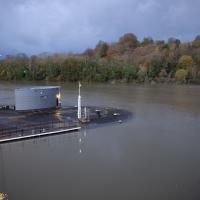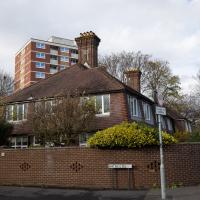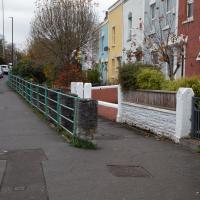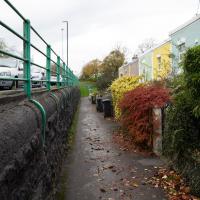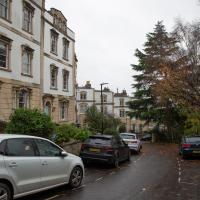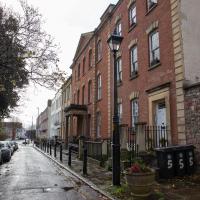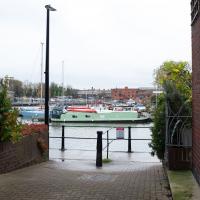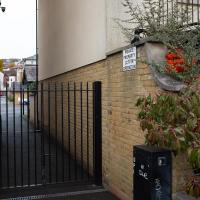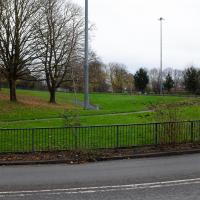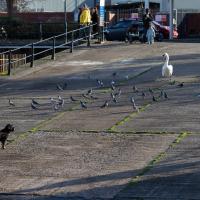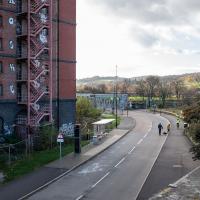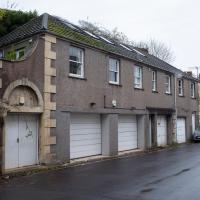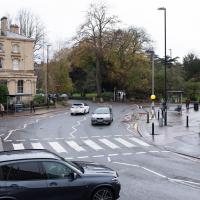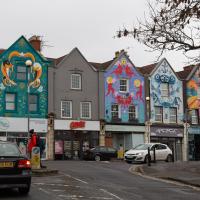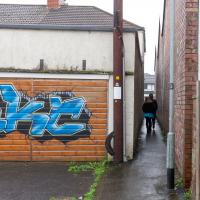Tagged: plant
Sunday Morning
15 Nov 2020
My friend Sarah mentioned the high tide and I managed to drag myself out early, though still a little late. We nearly drowned in torrential rain, but the weather changed quickly and we ended up walking over to Bedminster in sunshine.
I have since worked out how to use the milk vending machine, and very nice milk it is, too.
Sunday Afternoon
15 Nov 2020
A walk back from Bedminster to my place, mostly down Duckmoor Road, which I found a little dull—probably because it reminded me a little of the suburbs I grew up in on the outskirts of London—then held up slightly by some filming on Ashton Avenue Bridge. They were trying not to let the crowds build up too much in between takes, it seems, so it wasn't a long delay.
Dowry Square Jaunt
16 Nov 2020
A quick lunchtime jaunt to Dowry Square, which is very close to me but, being effectively a cul-de-sac as well as a square, I've probably only circumnavigated a couple of times in the last couple of decades.
I never need to walk down Polygon Road or Dowry Road. I couldn't say I've not been down these streets at all before the One Mile Matt project, but if I have it's been vanishingly rare and so long ago I don't remember it.
Jaunt to a Closed Coffee Shop
17 Nov 2020
A fruitless wander, as Spoke and Stringer (who I thought might do a decent flat white) were closed, and the only other harbourside inlet offering were a bit too busy to wait at, especially as I'd spent some time wandering some of the convolutions of Rownham Mead. This last congeries of dull alleyways and brown-painted garages was at least somewhere I've never been before, in parts.
There are yet more plans to turn this pub into yet more flats. I heard from a few different people that the owner has a habit of renting it to people but making them responsible for repairs, which normally turns out to be a bad deal for them as the place is falling apart. Of course, I've only heard that side of the story from the renters. I've experienced it in a few different forms, and in some of them it was a truly excellent local pub.
When the commuter ferry was still a thing—the council subsidy was cut in the wake of the last global recession—I used to wander through this little alleyway all the time to wait at the ferry stop at this little inlet for the boat to work. Happier times.
A lot of folks aren't fans of the architecture at Poole's Wharf, but I'd love to live in one of these houses.
According to Wikipedia, this sculpture was commissioned by the house builders who developed the site, designed by a student at the University of the West of England Art School with engineering by David Abel's Boatyard.
In which our intrepid hero levels up.
Quite a line-up. I'm afraid to say I've only read the obvious writer here; I've just popped Angela Carter's The Bloody Chamber on my "to-read" list to try and make up for that, but it's quite a long list right now.
I keep on thinking there might be a quick way to Greville Smyth from here, but I think the only shortcut is up that muddy slope to the staircase on the left. And it's quite steep and very slippery-looking, so I've never tried it.
The other way to get to Greville Smyth more quickly from there would be to go up that set of steps, but it would mean vaulting the railings, and I don't really do vaulting.
Quick Coffee
19 Nov 2020
A sunny day, and though I should have probably headed for less well-travelled territory I just headed over to the Marina to grab a flat white from Imagine That's horsebox café.
Clifton Village Mini Wander
20 Nov 2020
Just a quick wander up the hill to get a flat white from Twelve. I really enjoyed the spooky mannequin (?) in the window.
The one nearest is an AirB&B-style rental and looks lovely inside. This is the kind of quirkiness I might aspire to.
Many a time have I wandered down this little cut-through that joins Saville Place and the Fosseway. A shortcut through the Polygon starts me off, then it's pretty much a straight line up through to here and on to Queen's Road.
I'm not sure what's going on in this fanlight on Richmond Terrace. Maybe it's space for a lamp?
I wonder how many times I've crossed this zebra crossing, or cut across the road at the little traffic island in the background to get to the diagonal path across Victoria Square?
Bedmo and Ashton Court
21 Nov 2020
A rather more wide-ranging weekend wander with Sarah and Vik, taking in some mock Tudor bits of Bedmo (I should note that I've subsequently been corrected to "Bemmie", but I'm an outsider and have been calling it "Bedmo" for short for decades...), a chunk of Ashton, a path up Rownham Hill called Dead Badger's Bottom(!), The Ashton Court estate, a bit of the UWE campus at Bower Ashton, and some of the Festival Way path.
I have no idea how anyone managed to smack this street furniture so hard, or what direction they came from to do it. It's a pretty straight 30mph road right there, and this is only one side of the dual carriageway. Never seen so much as a near-miss there.
That a BMW came a tad too fast out of Clifton Vale, lost it completely and trashed the main control box for the traffic lights. It took them quite some time to fix it. I'd imagine his insurance company is getting quite the bill...
I'm not sure I'd be waiting literally in the road here if my car had broken down. The continual strewing of the pavements on these flyovers with broken bits of cars, vans and lorries, large and small, suggests that smashes are pretty frequent.
Underpass
25 Nov 2020
A quick lunchtime jaunt for coffee. I've often wondered about the dots on the wall of the underpass. Apparently they're not intelligible Braille. Maybe it's Marain :D
Given that it's on an unwalled bike shed, I doubt it's there for insulation. The CREATE centre my just have it there as an example of what an eco-friendly roof can look like, though.
Must be going through some hard times at the moment. I've been in a few times since I used to live at Baltic Wharf in the mid-nineties, and it's always been a slightly edgy-but-nice local pub that's reasonably welcoming of strangers, too. Plus it's a well-worn stop off for people on the way home from the footy.
At least someone's still watering the plethrora of plants that are arranged in Spike Island cafe's windows.
I don't think I ever crossed this bridge on foot before starting my "One Mile Matt" project.
When I first moved to Hotwells, there were still signs for the famous transport caff "Popeye's Diner", a well-known refuelling point for truckers on the way in or out of Bristol. It was also the cafe used for interior shots in some episodes of Only Fools and Horses. You can see it as it used to be in the "Trigger's broom" sketch, for one. These days it's a much posher affair, and they do a very good Eggs Benedict when they're open.
You can see a before/after comparison of how the interior looked when I moved to the area in the 1990s and how it looks now in this shot on Flickr that compares an Only Fools and Horses still with a modern shot.
I really must try another long-exposure with ND filters here; it looks very strange with the water made artificialy still like that, and I enjoy the effect.
Office? Control room? Whatever it is, I've always been a bit fascinated by the little suite of rooms under the north side of the Plimsoll Bridge. The little gantry is directly below the place where the swing bridge meets the road proper, so presumably it's there for inspections when the bridge is swung?
Apparently this isn't Braille. Could be Marain, I suppose. It's also on some of the pillars, from what I remember.
